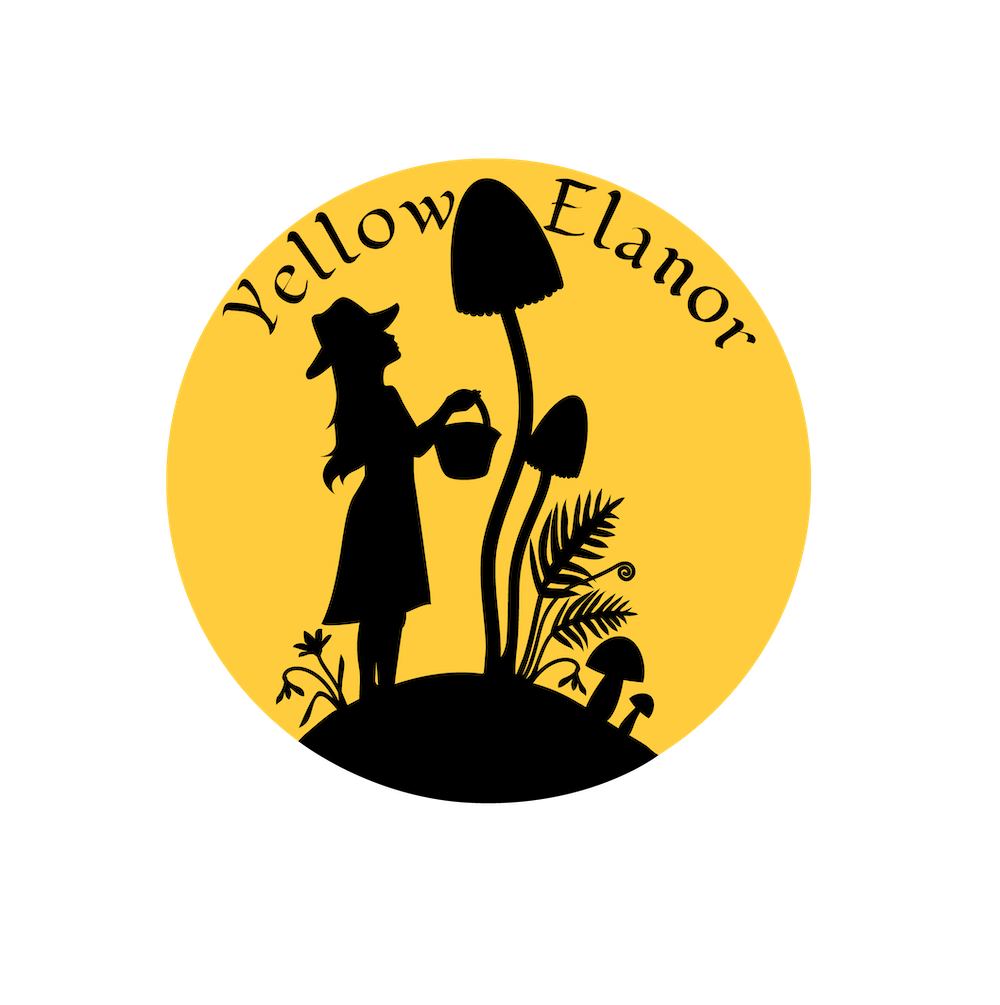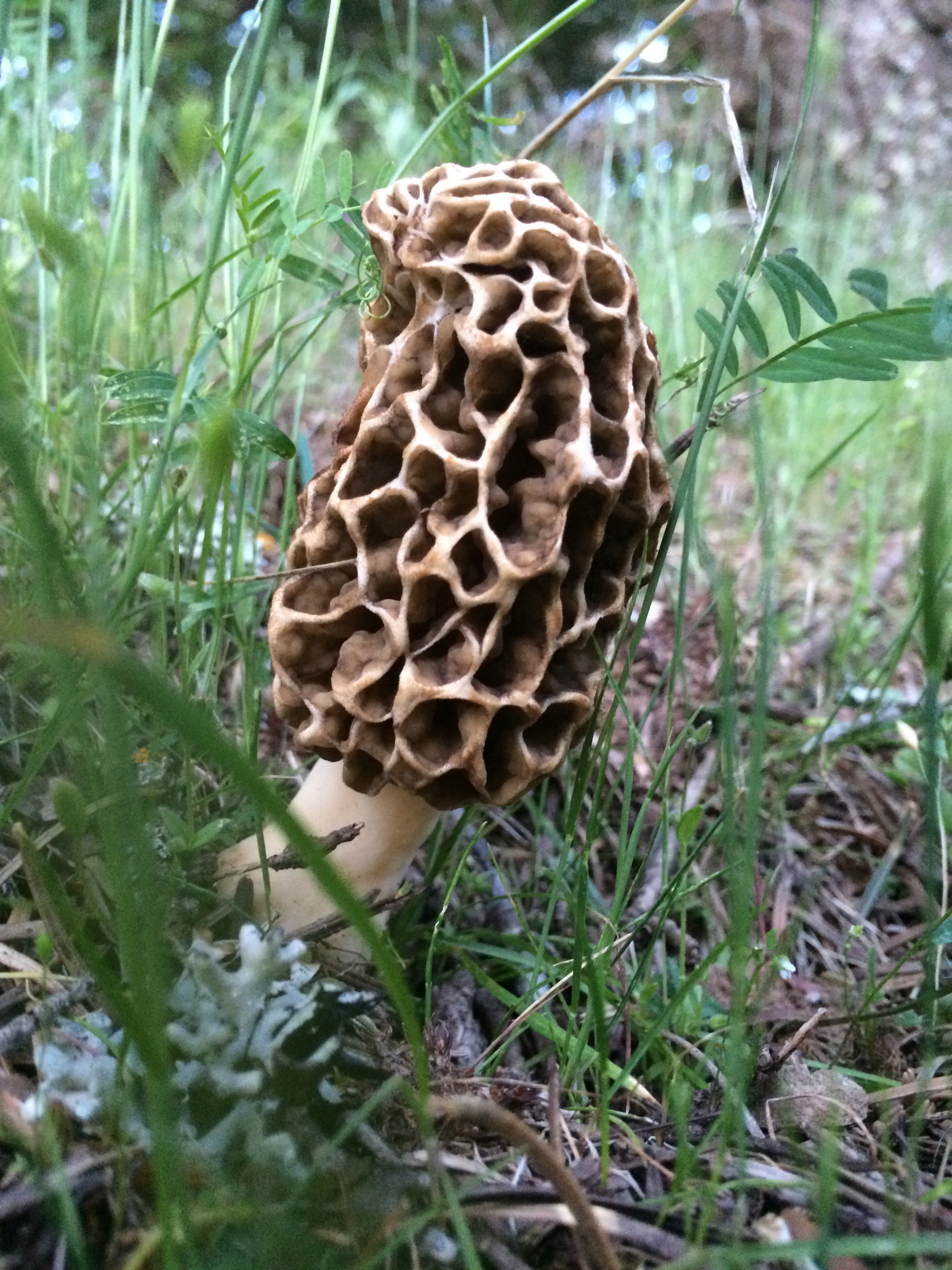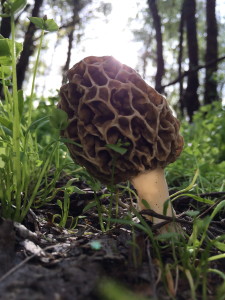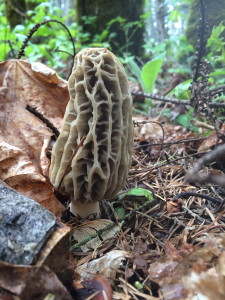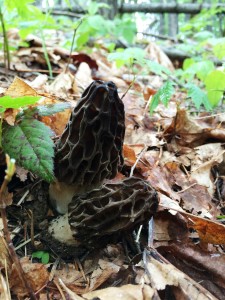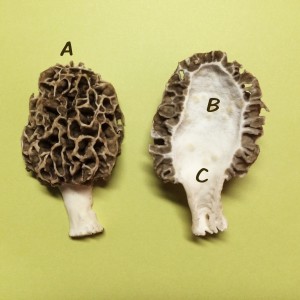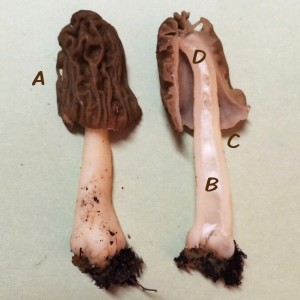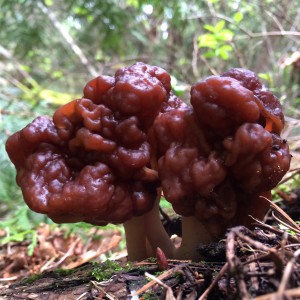What can I say about the Morel mushroom that hasn’t beens said a hundred times? The hunt for them can get contentiously competitive. Their flavor and the ‘hide and seek’ of finding them both contribute to this
The Morel is a wonderful first-time mushroom to identify for beginners. Because of it’s distinctive structure and popularity, it makes confirming your identification less challenging compared to other edible mushrooms.
Let’s take a look at the structure of a Morel mushroom
B) Hollow inside-both the cap and stem all the way through and through
C) Cap and Stem are attached at the bottom of the cap, fused together as if one, this makes separating the cap from the stem not easily separated.
Morels can come with slight variations from each other. Some are black, blonde, yellow, grey. Some are short and fat, others tall and thin. Despite the slight differences in outer appearance, the key identification points mentioned in the diagram will always stand true. If your mushroom does not have the features listed, it is probably not a true Morel.
Let’s take a look at some examples of false Morels:
The diagram is an example of a Verpa, probably most often confused with a true Morel. Stomach upset, vomiting and diarrhea can result from consumption of Verpa.
A) Cap is wrinkled and folded, a true Morel has pits. While they may look similar, examination of the cap will distinguish the difference between a false Morel’s wrinkles verse a true Morel’s pits.
B) Stem has a fibrous tissue inside, sometimes loosely packed and sometimes densely. A true Morel will not have this fibrous tissue, it will be completely hollow.
C) The bottom of the cap is not attached to the stem and hangs free. A true Morel’s cap and stem are fused and become one at this point.
D) Stem is attached at the very top of the cap, making it easy to pluck the cap from the stem.
Gyromitra esculenta is another false Morel, one that is deadly poisonous if eaten raw because of the toxins it contains.
Now, with that being said, let’s talk a little crazy for a second here…people will still sometimes eat both of those false Morels-on purpose! Through ‘proper preparation’, boiling out the toxins and being very careful, people will eagerly eat them. I, however, am not recommending it. Unless you’re well experienced and have been taught how to fully remove the toxins, then please steer clear of popping these into your mouth! Let me also add, the Gyromitra esculenta looks similar to other mushrooms across the globe, some don’t cary the same toxicity levels as these and are eaten regularly, but unless you have confirmed ID with an expert or are familiar with the mushroom already, never test fate.
Where to find the Morel mushrooms?
I can’t help but grin while I’m writing this, it seems like no matter how long someone has been hunting Morels they will welcome any kind of tips, tricks or pieces of information about how to locate them-because they like to hide! Often when someone finds a ‘patch’ of Morels, they will keep the location a secret from even their closets of friends.
When people ask me how to find Morels, I respond by saying, “Morels grow where Morels grow…”, the variety of places they can show up makes it hard to pin point a perfect hunting environment for them.
Here are the “Most Likely to Succeed” places to start your Morel hunt:
- Forest fire and burn locations, typically one to three years post-fire will produce Morels
- Logged areas that have been cleared in the past two to five years
- Apple orchards that have used lime, Morels like soil with high pH levels. Be careful of orchards they may have been sprayed with chemicals.
- Elm, Ash, Poplar, Sycamore and Cotton-Wood trees tend to have more Morels growing under them, find out which of these trees grow in your area and check under them in the spring.
Additional Hunting Tips:
- Morels are spring mushrooms, when the snow melts and the daytime temperature reaches 65 Fahrenheit (18 Celsius) while the nights are just above freezing, this a good time to start looking to see if they’ve started growing.
- Look at photos of Morels before you go out to hunt them. They blend into their surroundings and are easily missed. Looking at photos will help your eyes ‘calibrate’ to their natural camouflage.
- Don’t look down near your feet when you search, scan out in front of you a few yards, they will catch your eye easier this way.
- Dead or dying elm trees tend to coincide with Morel production.
Morel Care:
- When collecting Morels, cut them at the base of the stem leaving the dirt and roots in the ground.
- Collect them in a breathable container, a wicker basket or mesh bag. Plastic will smoother the Morels making them ‘sweat’ and won’t allow spores to fall back to the forest floor.
- Check inside of Morels for any critters that may be hiding, hollow Morels make for good homes.
- Clean Morels by soaking them in slightly salted water for a few hours, this helps remove any bugs.
- If not cooked up immediately then store in fridge covered by a slightly damp paper towel for up to 4-7 days.
- For long term storage, freeze or dry.
Happy and Safe Foraging to All!
“Do not consume while mushrooms unless they have been correctly identified as safe for consumption. Descriptions in this post are merely guidelines to begin the identification process.”
